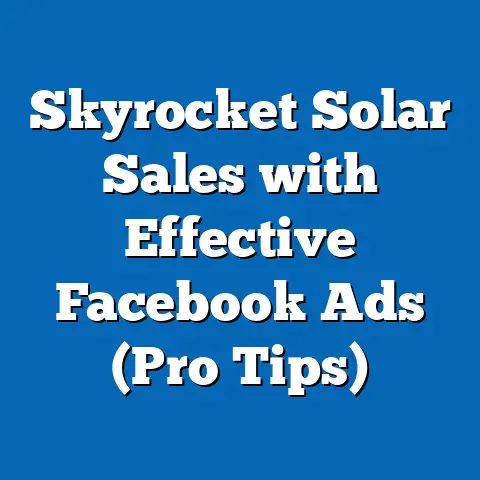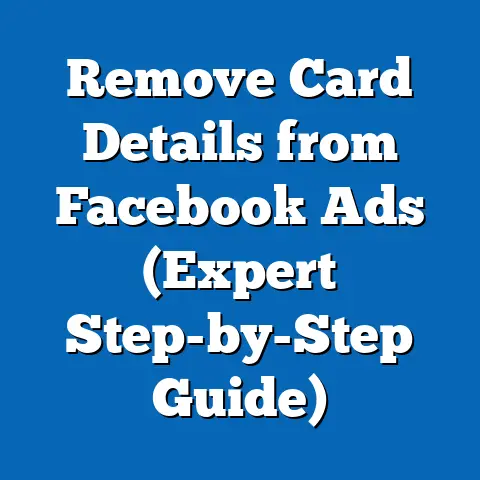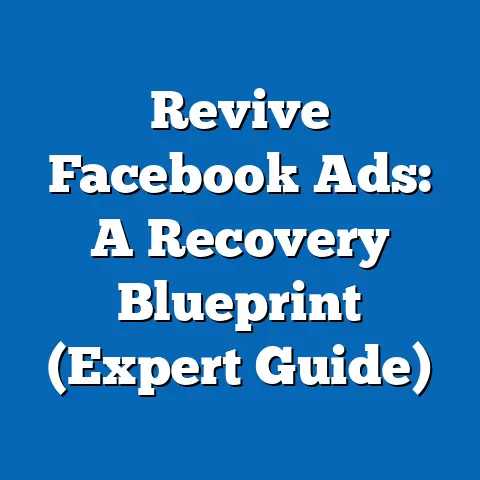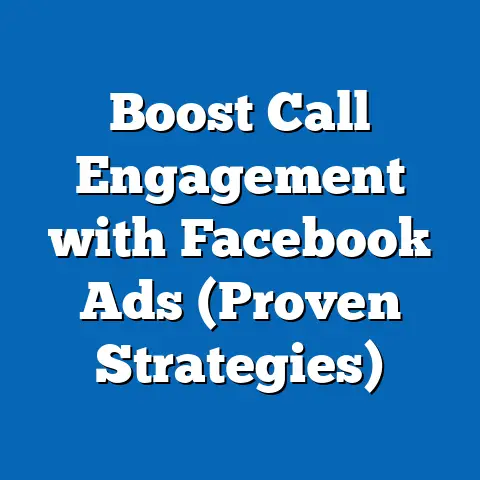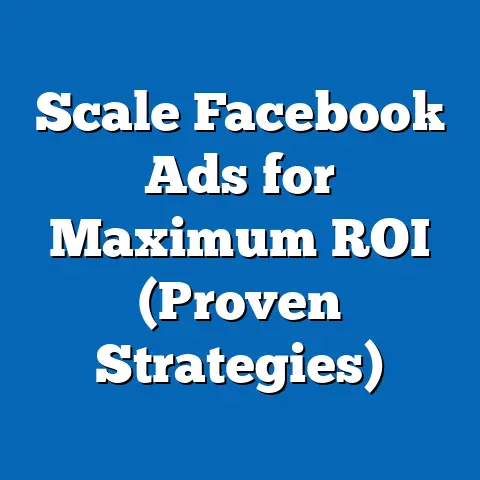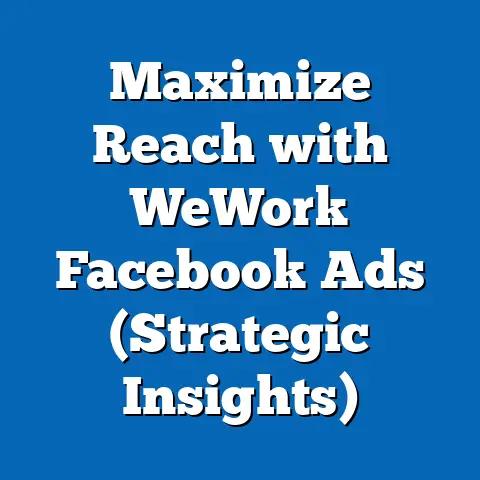Unlock Powerful Facebook Video Ad Examples (Proven Insights)
What makes a Facebook video ad not just good, but unforgettable? In today’s digital landscape, where attention spans are shrinking faster than ice cream on a hot summer day, video ads have emerged as the undisputed champions of engagement. Facebook, with its billions of active users, provides fertile ground for video ads to flourish. But let’s be honest, not all video ads are created equal. Some soar, captivating audiences and driving conversions, while others… well, they just blend into the background noise.
The Rise of Video Ads on Facebook
The Evolution of Advertising on Social Media
Remember the early days of Facebook advertising? Static images and text-based ads reigned supreme. They were simple, straightforward, and… frankly, often ignored. As social media evolved, so did user expectations. People craved richer, more engaging content. They wanted to be entertained, informed, and emotionally connected.
Video stepped in to fill that void. It offered a dynamic, immersive experience that static ads simply couldn’t match. And Facebook recognized this potential early on. They steadily improved their video advertising platform, adding features like auto-play, sound controls, and advanced targeting options.
Today, video ads are no longer a “nice-to-have” but a “must-have” for any serious Facebook advertiser. According to recent statistics, video ads generate significantly higher engagement rates compared to static ads. In fact, a study by HubSpot revealed that video ads on social media receive 1200% more shares than text and image content combined. That’s a staggering difference!
My own experience mirrors these findings. When I transitioned my clients from primarily static ads to video ads, I saw an immediate and dramatic increase in click-through rates (CTR) and conversion rates. It was like flipping a switch – suddenly, our ads were resonating with the audience in a way they never had before.
Takeaway: Video ads are the present and future of Facebook advertising. If you’re not leveraging video, you’re leaving money on the table.
Why Video Ads Work
So, what makes video ads so effective? It’s more than just shiny visuals and catchy tunes. The power of video lies in its ability to tap into our fundamental human psychology.
- Visual Dominance: Our brains are wired to process visual information far more quickly and efficiently than text. Studies show that we remember 80% of what we see, compared to only 20% of what we read. Video leverages this visual dominance, capturing our attention and conveying information in a concise and memorable way.
- Emotional Connection: Video allows you to tell stories, evoke emotions, and build a deeper connection with your audience. Think about those tear-jerking holiday commercials or the hilarious product demos that go viral. They resonate with us on an emotional level, making us feel something and remember the brand behind the message.
- Information Retention: As I mentioned earlier, we retain more information from videos than from text or images. This is because video combines visuals, audio, and motion, creating a multi-sensory experience that sticks in our minds.
- Increased Engagement: Video naturally encourages engagement. People are more likely to watch a video, share it with their friends, and leave comments than they are to interact with a static ad. This increased engagement translates into higher brand awareness, increased website traffic, and ultimately, more sales.
I remember working with a local bakery that was struggling to attract new customers. We created a short video showcasing their bakers crafting artisanal bread, highlighting the passion and care that went into each loaf. The video was simple, authentic, and incredibly effective. People were captivated by the behind-the-scenes look and the genuine love for baking. The result? A line out the door every morning!
Takeaway: Video ads work because they leverage our innate psychological biases, creating a more engaging, memorable, and emotionally resonant experience.
Key Elements of Successful Facebook Video Ads
Now that we understand why video ads are so powerful, let’s break down the key elements that contribute to their success.
Crafting a Captivating Hook
In the fast-paced world of social media, you have mere seconds to grab someone’s attention. The first few seconds of your video ad are crucial. They’re your hook – the thing that reels viewers in and makes them want to watch more.
A good hook should be:
- Intriguing: Pose a question, tease a solution, or hint at a surprise.
- Relevant: Immediately connect with your target audience’s interests and needs.
- Visual: Use eye-catching visuals and dynamic motion to draw the viewer in.
- Concise: Get straight to the point – don’t waste precious seconds with unnecessary introductions.
Here are some examples of effective hooks I’ve seen in successful Facebook video ads:
- Question: “Tired of struggling with [problem]? We have the solution.”
- Teaser: “You won’t believe what happened next…”
- Shocking Statistic: “Did you know that [shocking statistic]? Here’s how to avoid it.”
- Benefit-Oriented: “Discover the secret to [desired outcome] in just 5 minutes.”
I once worked with a fitness company that was struggling to get people to sign up for their online program. We decided to create a video ad with a simple, yet powerful hook: “Are you ready to finally achieve your dream body?” The ad then showed quick, visually appealing snippets of people working out and achieving their fitness goals. The hook was relatable, aspirational, and it immediately resonated with the target audience. Sign-ups skyrocketed!
Takeaway: Your hook is the gateway to your video ad. Make it intriguing, relevant, and visually appealing to capture attention and keep viewers engaged.
Storytelling Techniques
Humans are wired for stories. We’ve been telling stories since the dawn of time, and they remain one of the most powerful ways to connect with others, convey information, and evoke emotions.
Incorporating storytelling techniques into your video ads can significantly enhance their impact and effectiveness.
Here are some storytelling techniques I’ve found to be particularly effective:
- The Hero’s Journey: This classic narrative structure involves a hero (your customer) who faces a challenge, overcomes obstacles, and ultimately achieves a desired outcome with the help of your product or service.
- Problem-Agitation-Solution (PAS): This simple framework starts by identifying a problem your audience faces, agitating the pain points associated with that problem, and then presenting your product or service as the solution.
- Before-After: This technique visually demonstrates the transformation your product or service can provide, showing the “before” state of the customer’s life and the improved “after” state.
- Customer Testimonials: Real-life stories from satisfied customers can be incredibly powerful. They provide social proof and build trust in your brand.
I remember working with a non-profit organization that was struggling to raise donations. We created a video ad that told the story of a young girl whose life had been transformed by their programs. The video showed her struggles, her hopes, and her ultimate success. It was a deeply moving story that resonated with viewers on an emotional level. Donations poured in, and the organization was able to help even more children in need.
Takeaway: Storytelling is a powerful tool for connecting with your audience on an emotional level, building trust, and driving action.
Clear Call-to-Action (CTA)
You’ve crafted a captivating video ad, told a compelling story, and captured your audience’s attention. Now what? You need to tell them what you want them to do next. This is where your call-to-action (CTA) comes in.
A strong CTA should be:
- Clear: Use concise and direct language that leaves no room for ambiguity.
- Action-Oriented: Use verbs that encourage action, such as “Shop Now,” “Learn More,” “Sign Up,” or “Download.”
- Prominent: Make your CTA visually stand out using contrasting colors, bold text, or a dedicated button.
- Urgent: Create a sense of urgency by using phrases like “Limited Time Offer” or “Shop Now Before It’s Too Late.”
Here are some examples of effective CTAs I’ve seen in successful Facebook video ads:
- E-commerce: “Shop Now and Get 20% Off Your First Order!”
- Lead Generation: “Download Our Free Guide to [Topic]!”
- App Downloads: “Install Now and Start [Benefit] Today!”
- Event Promotion: “Register Now and Secure Your Spot!”
I once worked with an online course creator who was struggling to convert video ad viewers into paying students. We analyzed their existing ads and realized that their CTA was weak and buried at the end of the video. We revamped their CTA, making it more prominent, action-oriented, and urgent. We also placed it throughout the video, reminding viewers of the next step. The result? A significant increase in course enrollments.
Takeaway: A clear and compelling CTA is essential for driving conversions. Make it prominent, action-oriented, and urgent to encourage viewers to take the desired next step.
Unlocking Proven Facebook Video Ad Examples
Let’s move on to some real-world examples of successful Facebook video ad campaigns and dissect what made them work. I’ll share some of my own experiences and insights, drawing on my years of experience in the field.
Case Study 1 – Dollar Shave Club: “Our Blades Are F***ing Great”
Dollar Shave Club’s viral video ad is a masterclass in low-budget creativity and irreverent humor. The video features the company’s CEO, Michael Dubin, walking through their warehouse, delivering a series of witty and memorable lines about their razor blades.
- Objectives: Increase brand awareness and drive subscriptions to their razor blade delivery service.
- Execution: The video was shot on a shoestring budget, but it was brilliantly written and executed. Dubin’s deadpan delivery and the video’s self-deprecating humor resonated with viewers.
- Results: The video went viral, generating millions of views and driving a massive surge in subscriptions. Dollar Shave Club quickly became a household name, disrupting the traditional razor blade market.
What Made It Successful:
- Humor: The video was genuinely funny, making it highly shareable.
- Authenticity: Dubin’s personality shone through, making the brand feel relatable and genuine.
- Clarity: The video clearly communicated the company’s value proposition – high-quality razor blades at an affordable price.
- Memorable: The video’s catchphrases and visuals stuck in viewers’ minds.
Key Takeaways:
- You don’t need a massive budget to create a successful video ad.
- Authenticity and humor can go a long way.
- Clearly communicate your value proposition.
- Create something memorable that will stick in viewers’ minds.
Case Study 2 – Airbnb: “Belong Anywhere”
Airbnb’s “Belong Anywhere” campaign is a powerful example of storytelling at its finest. The video features a diverse group of people sharing their experiences of traveling and connecting with locals through Airbnb.
- Objectives: Reinforce Airbnb’s brand values of community and belonging.
- Execution: The video used authentic footage and heartfelt testimonials to showcase the transformative power of travel and human connection.
- Results: The campaign resonated deeply with viewers, reinforcing Airbnb’s brand image and driving bookings.
What Made It Successful:
- Emotional Connection: The video tapped into viewers’ desire for travel, adventure, and human connection.
- Authenticity: The use of real people and their stories made the video feel genuine and relatable.
- Brand Alignment: The video perfectly aligned with Airbnb’s brand values of community and belonging.
- Visually Stunning: The video featured breathtaking scenery and captivating visuals.
Key Takeaways:
- Tell stories that resonate with your audience’s values and aspirations.
- Use authentic footage and testimonials to build trust and credibility.
- Ensure your video aligns with your brand’s values and messaging.
- Invest in high-quality visuals.
Case Study 3 – Old Spice: “The Man Your Man Could Smell Like”
Old Spice’s “The Man Your Man Could Smell Like” campaign is a brilliant example of how to revitalize a classic brand and appeal to a new generation of consumers. The video features Isaiah Mustafa, a charismatic and humorous spokesperson, delivering a series of witty and absurd lines while seamlessly transitioning between different scenes.
- Objectives: Increase brand awareness and drive sales among younger consumers.
- Execution: The video was incredibly creative and engaging, featuring a unique blend of humor, charm, and absurdity.
- Results: The campaign went viral, generating millions of views and driving a significant increase in Old Spice sales.
What Made It Successful:
- Humor: The video was hilarious and highly shareable.
- Charismatic Spokesperson: Isaiah Mustafa’s charm and charisma made the video incredibly engaging.
- Unique Concept: The video’s unique blend of humor and absurdity set it apart from other advertising campaigns.
- Interactive Elements: The campaign included interactive elements, such as personalized video responses from Isaiah Mustafa, which further amplified its reach and engagement.
Key Takeaways:
- Don’t be afraid to take risks and try something different.
- Find a charismatic spokesperson who embodies your brand’s values.
- Create a unique concept that will capture attention and generate buzz.
- Incorporate interactive elements to further engage your audience.
Best Practices for Creating Facebook Video Ads
Now that we’ve dissected some successful examples, let’s dive into some best practices for creating your own Facebook video ads.
Understanding Your Audience
Before you even start thinking about visuals or scripts, you need to understand your audience. Who are you trying to reach? What are their interests, needs, and pain points? What kind of content do they engage with on Facebook?
The more you know about your audience, the better equipped you’ll be to create video ads that resonate with them and drive results.
Here are some methods for gathering insights about your audience:
- Facebook Audience Insights: This powerful tool provides detailed demographic and psychographic information about your target audience.
- Customer Surveys: Ask your existing customers about their preferences, needs, and pain points.
- Social Listening: Monitor social media conversations to gain insights into what your target audience is talking about and what they care about.
- Competitor Analysis: Analyze your competitors’ Facebook ads and social media content to see what’s working for them.
I always tell my clients that understanding your audience is like having a cheat sheet for success. It allows you to tailor your messaging, visuals, and targeting to maximize your impact.
Takeaway: Deeply understand your audience before creating your video ads. Use data and research to inform your creative decisions.
Optimizing for Mobile
In today’s mobile-first world, optimizing your video ads for mobile devices is absolutely essential. The vast majority of Facebook users access the platform via their smartphones, so your ads need to look and perform flawlessly on mobile screens.
Here are some tips for creating mobile-friendly video ads:
- Use Vertical Video: Vertical video takes up the entire screen on mobile devices, creating a more immersive and engaging experience.
- Keep it Short and Sweet: Mobile users have short attention spans, so keep your videos concise and to the point. Aim for 15-30 seconds.
- Use Captions: Many mobile users watch videos with the sound off, so use captions to ensure that your message is still conveyed.
- Optimize for Slow Connections: Compress your video files to ensure that they load quickly, even on slow internet connections.
- Test on Different Devices: Test your video ads on a variety of mobile devices to ensure that they look and perform as expected.
I remember working with a restaurant that was running video ads to promote their lunch specials. Their initial ads were horizontal and featured a lot of text. They looked terrible on mobile devices and were generating very little engagement. We revamped their ads, creating vertical videos with clear visuals and concise captions. The results were dramatic – engagement skyrocketed, and the restaurant saw a significant increase in lunch traffic.
Takeaway: Optimize your video ads for mobile devices to ensure that they look and perform flawlessly on smartphones.
Analyzing Performance Metrics
Creating great video ads is only half the battle. You also need to track their performance and make adjustments as needed.
Here are some key performance indicators (KPIs) to track for video ads on Facebook:
- Reach: The number of unique people who saw your ad.
- Impressions: The number of times your ad was displayed.
- Video Views: The number of times your video was watched for at least 3 seconds.
- Video Completion Rate: The percentage of people who watched your video all the way through.
- Click-Through Rate (CTR): The percentage of people who clicked on your ad.
- Conversion Rate: The percentage of people who took the desired action after clicking on your ad (e.g., making a purchase, signing up for a newsletter).
- Cost Per Result (CPR): The average cost of achieving your desired result (e.g., a purchase, a lead).
By tracking these metrics, you can identify what’s working and what’s not, and make adjustments to your targeting, creative, or bidding strategies to improve your results.
I always encourage my clients to set up a robust tracking system and regularly analyze their performance data. This allows them to make data-driven decisions and continuously optimize their campaigns for maximum ROI.
Takeaway: Track your video ad performance and use data to inform your optimization efforts.
Future Trends in Facebook Video Advertising
The world of Facebook video advertising is constantly evolving. New technologies, trends, and best practices are emerging all the time. To stay ahead of the curve, it’s important to be aware of these trends and adapt your strategies accordingly.
The Impact of AI and Automation
Artificial intelligence (AI) and automation are already having a significant impact on Facebook video advertising, and their influence will only continue to grow in the future.
AI-powered tools can help you:
- Automate Ad Creation: AI can generate video ads based on your existing content and brand guidelines.
- Optimize Targeting: AI can identify the most relevant audiences for your video ads based on their interests, behaviors, and demographics.
- Personalize Ads: AI can personalize video ads based on individual user preferences and behaviors.
- Improve Bidding: AI can automate your bidding strategies to maximize your ROI.
I’ve been experimenting with AI-powered ad creation tools and have been impressed with their ability to generate high-quality video ads quickly and efficiently. While they’re not a replacement for human creativity, they can be a valuable tool for scaling your video ad production.
Takeaway: Embrace AI and automation to streamline your video ad creation, targeting, and optimization processes.
User-Generated Content (UGC)
User-generated content (UGC) is becoming increasingly popular in Facebook video advertising. UGC is content created by your customers or fans, rather than by your brand.
UGC can be incredibly effective because it’s:
- Authentic: UGC feels more genuine and relatable than branded content.
- Trustworthy: People are more likely to trust recommendations from other customers than from brands.
- Cost-Effective: UGC can be a cost-effective way to create high-quality video ads.
I’ve seen brands successfully incorporate UGC into their video ads by featuring customer testimonials, product reviews, or behind-the-scenes footage of customers using their products.
Takeaway: Leverage user-generated content to build trust, increase authenticity, and create more engaging video ads.
Interactive Video Ads
Interactive video ads are a relatively new format that allows viewers to interact with the video content directly. This can include things like quizzes, polls, games, or clickable hotspots.
Interactive video ads can be incredibly effective because they:
- Increase Engagement: Interactive elements encourage viewers to actively participate in the video experience.
- Gather Data: Interactive ads can collect valuable data about viewer preferences and behaviors.
- Personalize the Experience: Interactive ads can personalize the video experience based on viewer responses.
I’ve seen brands use interactive video ads to promote new products, run contests, or educate viewers about their brand values.
Takeaway: Experiment with interactive video ads to increase engagement, gather data, and personalize the viewer experience.
Conclusion
Facebook video ads are a powerful tool for reaching your target audience, building brand awareness, and driving conversions. By understanding the key elements of successful video ads, following best practices, and staying up-to-date with the latest trends, you can unlock significant growth for your business on Facebook.
Remember, creating effective video ads is an ongoing process of testing, learning, and optimization. Don’t be afraid to experiment with different formats, messaging, and targeting strategies to find what works best for your brand.
And most importantly, always put your audience first. Create video ads that are relevant, engaging, and valuable to them, and you’ll be well on your way to achieving your Facebook advertising goals.
So, go forth and create some unforgettable video ads! I’m excited to see what you come up with.

